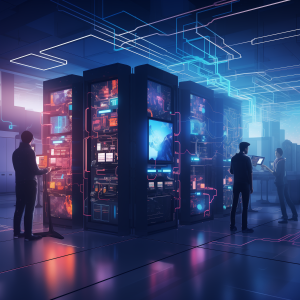Research Statement: Navigating the Confluence of AI, Arts, and Design
In the evolving modern technology we are in, my journey as a graphic designer, UX/UI designer, typographer, and aspiring web developer finding the intersection where artificial intelligence (AI) meets cultural and artistic expressions will be the ground for my research project. My aim is to explore the impact and integration of AI within the realms of graphic design, typography, color theory, and web development. The purpose for my project is to understand how AI can serve not only as a tool for creation but also as a partner in conceptualization, planning, and realizing visual assets that align with and expand upon my creative visions.
I envision this project as a dialogue between my creative instincts and the algorithmic logic of AI. It is an exploration of how these different modes of thinking can complement and challenge each other, leading to innovative outcomes that transcend traditional boundaries. By documenting my process and findings, I hope to provide insights and inspiration for others at the intersection of these fields, encouraging a collaborative approach to navigating the complexities of this digital age. My goal is to not only expand my own capabilities but also to contribute to the broader conversation about the future of design and the arts in the AI era.
Clarity on my Interest
My approach with this project is to show the potential of AI to enhance and transform traditional design and artistic practices. My main interests lie with graphic design, ux/ui, web development, and typography and color theory for this project. These topics are of great interest to me as they are areas in my profession where AI is now being integrated and I am curious to see the extent in which AI can be used in my profession as a creative tool.
I will explore this project with the focus of the AI influence in visual communication and conveying complex messages and emotions, perhaps some kind of generative art. In the UX/UI area, my focus will be with AI creating intuitive and engaging interfaces that enhance user experience and accessibility. Exploring AI in typography and color theory will be by exploring the role of AI in how it delivers feedback in areas of readability, mood, and overall aesthetic appeal of something. Finally in web development I think I can explore how AI offers a canvas for integrating these elements into cohesive, interactive experiences for a user. By having AI contribute into these areas, I seek to push the boundaries of what is possible, exploring new forms of creativity and collaboration between human and machine intelligence while documenting my process.
As for the application of AI in my project, it will be multifaceted. I plan to use AI as a sounding board for my ideas, leveraging its capacity for rapid iteration and feedback to refine concepts and visual designs. AI algorithms can generate diverse typographic styles and color palettes, offering fresh perspectives and solutions that may not be immediately apparent. In web development, AI can streamline the design process, from layout generation to user testing, enabling more efficient prototyping and optimization.
A significant part of my research will involve experimenting with specific AI tools and platforms that cater to creative professionals like me. This will include generative art software, AI-based design assistants, and machine learning frameworks that can analyze and predict user engagement with different design elements. Through this experience, I aim to identify and reflect on the most effective ways to integrate AI into the design workflow, assessing both the benefits and limitations of these technologies. Through this experience and documentation, I aim to dig deep into the potential of AI in enhancing human creativity, focusing on my findings and insights of the benefits, challenges, and drawbacks of this kind of AI-enhanced creative work tool. My project seeks to illuminate the pathways through which artists and designers can harness AI to expand the horizons of what is possible, setting a foundation for future explorations in AI in the arts.
